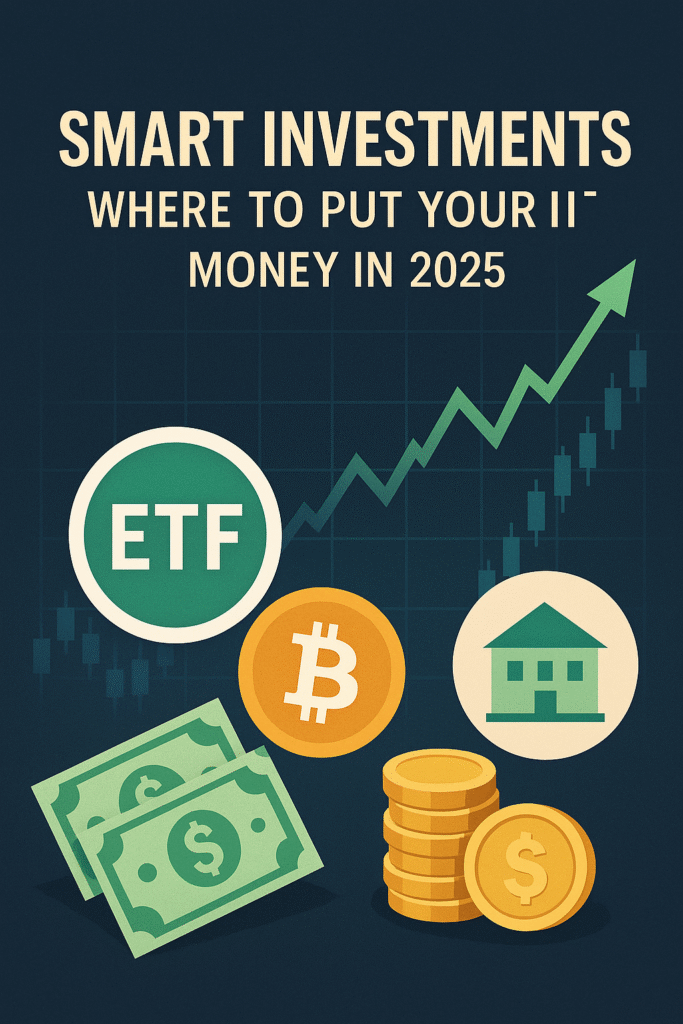
Chapter 2 – Smart Investments: Where to Put Your Money in 2025
Once you’ve built the discipline to save, the next step is choosing Smart Investments that let your dollars work for you. In 2025, inflation, rates, and tech disruption make asset selection more important than ever. The goal isn’t to chase hype; it’s to build a portfolio you can hold through cycles—one that compounds quietly while you sleep.
Fixed income sets the floor for your plan: Treasuries, high-quality bonds, and even high-yield savings provide stability and liquidity. In the U.S., you can buy bills and bonds directly at TreasuryDirect.gov, or through brokers such as Vanguard and Fidelity. Yields remain attractive relative to much of the last decade, which means safety no longer has to mean zero return. Keep part of your emergency buffer here so market drawdowns don’t force you to sell equities at the worst time.
For growth, broad-market ETFs are the workhorses of Smart Investments. An S&P 500 core (e.g., SPY/VOO) spreads risk across leading U.S. companies, while a Nasdaq-100 sleeve (e.g., QQQ) tilts toward tech innovation. Research from Morningstar shows diversified, low-cost index funds tend to outperform most stock pickers over long horizons. Automate monthly contributions, reinvest dividends, and let compounding do the heavy lifting.
Beyond the core, allocate a measured slice to emerging technologies—AI, quantum computing, automation/robotics, and biotech. You can express this view with individual names (e.g., automation platform providers or quantum hardware firms) or with thematic funds such as ARKK. This is where FURI – Follow Your Intuitions meets research: size positions small, demand clear roadmaps, and accept higher volatility in exchange for optionality.
Real estate offers diversification, income, and a different return stream. If you don’t want landlording, consider REITs you can buy in any brokerage account. Sector performance (industrial, residential, healthcare, data centers) rotates—use resources from Nareit to understand cash flows, payout ratios, and interest-rate sensitivity. Reinvest distributions when you can; over time, yield + growth can materially boost total return.
On the frontier sits crypto. The speculative mania faded, but infrastructure matured. U.S. Bitcoin ETFs provide regulated exposure without self-custody. Treat this as a small, intentional slice of the portfolio: it’s highly volatile, but offers asymmetric upside. Balance curiosity with rules—rebalance periodically, avoid leverage, and never let a single theme dominate your plan. For fundamentals and risk primers, see Investopedia: Bitcoin.
How does this translate into action? Think in layers. A simple example for illustration (not advice): 30–40% high-quality fixed income for ballast; 40–50% broad-market ETFs (S&P 500 / total market) as your core engine; 5–15% tech thematics (AI/automation/quantum) sized for volatility; 5–15% REITs for diversified income; 0–5% crypto/Bitcoin ETF for optionality. Adjust ranges to your horizon and risk tolerance, automate contributions, and review annually rather than daily.
Smart Investments are less about prediction and more about preparation. Build a diversified core, add small satellites where your conviction is strongest, and protect the downside so you can stay invested. Your money becomes a team of employees—some steady, some ambitious—and your role is to assign them wisely and keep them working together over time.
References & Further Reading
- U.S. Treasury – TreasuryDirect (buy bills/notes/bonds directly)
- Vanguard – index funds, research, retirement tools
- Fidelity – brokerage, fixed income ladders, IRAs
- Morningstar – fund/ETF research and performance
- Nareit – Real Estate Investment Trusts education
- ARK Innovation ETF (ARKK) – thematic innovation exposure
- Investopedia: Bitcoin – primer on crypto basics & risks
- Investor.gov Compound Interest Calculator – plan contributions and growth
- Chapter 1 – Financial Education & Saving (FollowFURI)
- FOLLOWFURI.COM – Projects & Books
